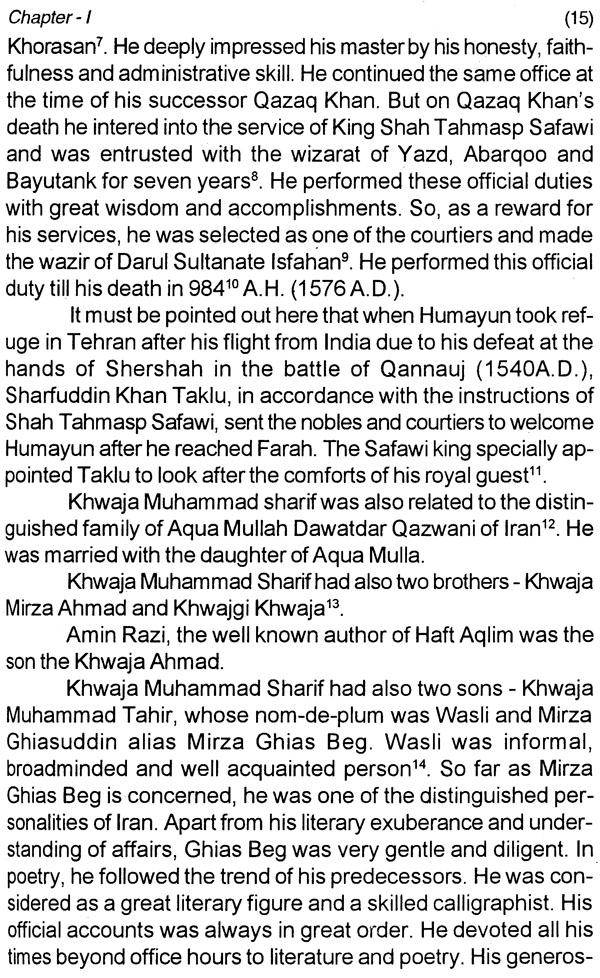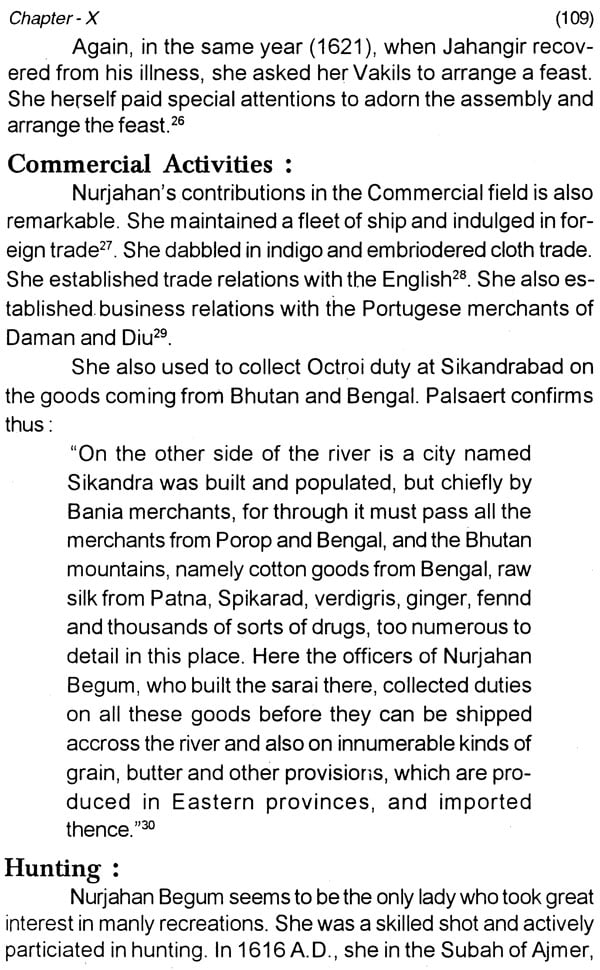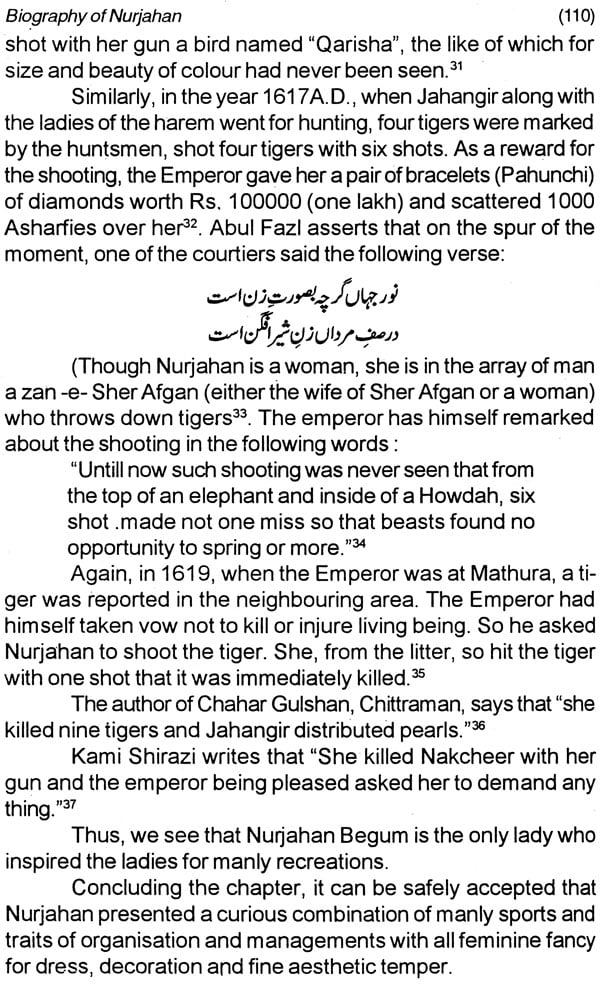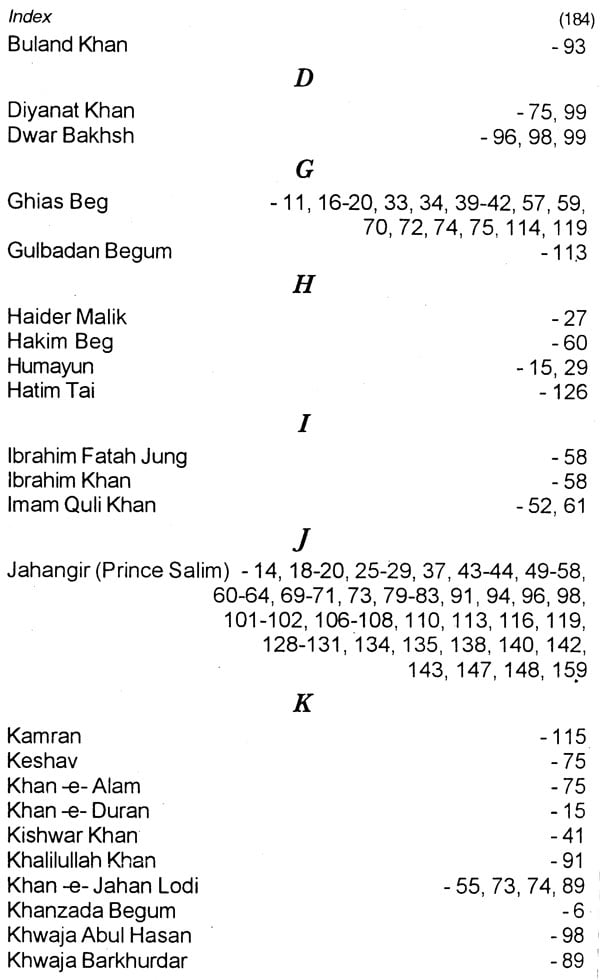
Biography of Nurjahan
Book Specification
| Item Code: | NAH802 |
| Author: | Abu Sufian |
| Publisher: | MUNSHIRAM MANOHARLAL PUBLISHERS PVT LTD |
| Language: | English |
| Edition: | 2018 |
| ISBN: | 9788121513241 |
| Pages: | 207 (7 B/W Illustrations) |
| Cover: | Hardcover |
| Other Details | 8.5 inch X 5.5 inch |
| Weight | 360 gm |
Book Description
Among the ladies of the Imperial Mughals, Nurjahan Begum, the beloved Queen of Jahangir occupies a very unique position. She was a woman of destiny and had a meteoric career. She had intensed love for Jahangir and the emperor reposed great confidence in her. She was a friend of the poor and the sufferers. She liberally contributed to the field of art and learning. She revolutionized dress, decorations and ornaments to a great extent. As a great Mughal Queen, She not only enhanced the splendor of the Mughal court, but also played a signficant role towards the sociocultural advancement of the age. She remained faithful to Jahangir when he was alive and even after his death, it was she, who performed the last rites when most of the relations and friends of the late emperor quickly deserted him.
Though many poems, dramas, novels and historical fiction have been written on Nurjahan, a historical biography has not been attempted so far. The present monography is a humble endeavour to remove the fable and fancies and to present before the reader the career and life sketch of this noble lady based mainly on original sources. It will be, of course, a welcome addition to the studies of Mughal India.
Born in 1951 in an educated family of Munger, the historical capital of Mir Quassim, the Nawab of Bengal. He proves a worthy son of Ruhul Quds, a gold medalist from Calcutta University and a renowned lawyer. He got his and education from Bhagalpur University has been rendering his services in Kendriya Vidyalaya Sangathan, the premier educational organisation of Ministry of HRD, Govt of India for the last 29 years. He revels in studies of books, historical research, reflective thinking and Aesthetic.
Status enjoyed by the woman is the yardstick to assess the standard of any age or country. The Indian tradition has always shown great respect to womanhood. Since the ancient time to the Mughal period, the ladies of the ruling dynasty enjoyed considerable prestige and power. They weilded a workable authority both over the emperor and the empire.
Among the ladies of the Imperial Mughals, Nurjahan Begum, the beloved queen of emperor Nuruddin Jahangir occupies a very unique position. She was a woman of destiny and had a meteoric career. As a great Mughal queen, she not only enhanced the splendour of the Mughal Court but also palyed a significant role towards the socio-cultural advancement of the era.
She had intense love for Jahangir. She looked after the emperor with unparalleled care and devotion. Jahangir reposed great confidence in her. As a result of her extra-ordinary love and devotion to the emperor she enjoyed great infulence and authority. The emperor as a token of unusual fondness and affection to the empress honoured her with lofty titles such as Nurmahal, Nurjahan and finally to the exceptional rank of Badshah Begum, the first lady of the realm which was usually given to the emperor's mother or the elderly sister of the emperor.
Though, many poems, dramas, novels and historical fictions have been written on Nurjahan, yet a historical biography has not so far been attempted.
The present monograph is a humble endeavour in this direction. There is no scarcity of materials on the theme, but there has been conflicts and controversies, guesswork and imaginations and writers have used their own whims and fancies. I have taken all pains to check all materials and reconstruct the career and the life sketch based mainly on original sources.
I am beholden to my reverred 'guru' Late Dr. P. P. Sinha, Ex-Principal R.D. &D.J. College Munger. I feel proud of having worked under his inspiring guidance and affectionate care. Wherever I got detracked, he made corrections and suggested improvements. In spite of his busy schedule he found time to write the foreword of the monograph. I wish to offer my grateful thanks and respectful regards.
I also express my deep sense of-gratitude to Late Dr. S. H. Askari, the grand old historian of Medieval India, who, in course of my research work extended his invaluable suggestions and tips in solving the knotty and controversial issues of the subject.
I shall be failing in my duty, if I dont express my sincere thanks to Mrs. Chandra Pant, reader in Medieval Indian History, Allahabad University. In course of my research work, when I was stationing at Allahabad, She provided me important books and materials related to the subject and gave inestimatable suggestions. I owe a special sense of gratitude for her.
My sincere thanks are due to Dr. Prof. Yahya Abdali, Ex-Head of the department of Urdu & Persian, R.D.&D.J. College Munger for extending his cooperation’s related to the topic.
I also express my deep sense of appreciation to my younger brother Abu Sahban Ruhul Quds Nadwi (the author of Rawa-e-al-Alaqe in Arabic - an annotation of Tahzib-al-Akhlaqe by A. H. Hasani) for his sincere cooperation in the completion of the work.
It is my pious duty to express my thanks and gratitude for the co-operation extended to me by the staff members of Khuda Bakhsh Oriental Public Library, Patna, Patna Museum, Arabic and Persian Research Institute, Patna, Allahabad Museum, Allahabad Archives, Allahabad University Library, Rampur Library Rajasthan State. Archives Bikaner State Archives Lucknow, Lucknow Museum, Shibli Nomani Library Nadwa, Lucknow, D.J. College Library, Munger, Khanquah Rahmani Library, Munger and Sri Krishna Sewa Sadan, Munger.
Last but not least, I give my heartful thanks to my wife and children for their moral support towards the completion of the work.
I owe a word of apology to all for a drawback, if any, in my work, which I hope to rectify in a subsequent edition.
It gives me great pleasure to introduce the present monograph on Nurjahan prepared by Dr. Abu Sufian. I have watched with great interest the completion of the research work on the biography of the famous Nurjahan. Nurjahan is really a popular, though neglected theme in the medieval history. Here is a successful attempt to present a systematic biography of the famous Mughal lady.
The thesis consists of eleven well written chapters be-sides introduction and resume. The scholar has creditably critised all the contemporary Persian chronicles, epigraphical and numismatic sources, portraits and paintings besides the accounts of foreign travellers. The chapters deal in detail Nurjahan's ancestry and early life, the famous Sher Afgan episode, circumstances leading to her marriage with Salim and her meteoric rise to the highest position in the state. She really proved to be a woman of destiny and as Badshah Begum she assumed all powers and ruled over both the emeror and the empire. But all this was not just because of her beauty but also due to her great devotion arid her God gifted merits and talents.
Dr. A. Sufian has critically examined all the controversial aspects of her period on basis of fresh evidences labouriously collected. Nurjahan was not only a beautiful beloved but also a successful ruler, astute diplomatist but excelled in military strategy and political manouvres when she could successfully get the release of the emperor from the clutches of Mahabat Khan. She also excelled in manly sports and proved unrivalled in hunting.
Nurjahan's cultural contributions add an attractive trait to her biography. Whether it was in the sphere of dress and decoration, cosmetics and ornaments, charity and benevolence, feasts and festivals, laying down of beautiful gardens and big sarais, she surely made some innovations and definitely made her contributions felt even in those days. Her literary-and poetic traits give a new dimension to her career. I am also glad that the literary style of the thesis (Monograph) is quite upto the mark and gives a pleasant reading. One special feature of the work is that one gets a close-up picture of Nurjahan, the emperor Jahangir and almost all the important political and military figures like Mahabat Khan, Ghias Beg, Asaf Khan and others who I appear on the political stage during this momentous period.
I hope this Biography will prove to be a welcome addition to the biographical literature of the time. I congratulate the scholar and wish him god' speed.
Biography is an integral part of History and great men and women have moulded the destinies of nations through ages. Since the ancient time, a number of ladies have played a leading role towards the multidimensional advancement of their age. Their contributions have been regarded as a historical epoch. To name only a few, we have Kumardevi (a Lichhwi queen who ruled over the kingdom conjoinely with her husband Chandragupta I about 320 A.D.), Dhuruvswamini (ruled over the vast Rashtrakut kingdom conjointly with her husband Dhuruva during eight century A D.), Arjurnand Dokht and Puran Dokht (the daughters of Khusro Perwez of the Sassanian dynasty ruled over Persia in the seventh century) and Razia Begum the first Muslim lady ruler who ruled over India from 1236-40 AD.
Coming down to the Mughal period, we see that a number of ladies have played important roles in shaping the socio-economic and political setup of the Mughal empire. But their contributions have a little been studied in a proper perspective. In the annals of the different chronicles we have the names of Khanzada Begum, the aunt of Humayun, Nurjahan, wife of Jahangir and Zebunnisa Begum, the daughter of Alamgir and various others. But no name in Medieval Indian history can rival than that of Nurjahan in importance and popularity. Yet, her biography has remained obsecured and whatever is known to us is as good as fiction based on imagination than reality.
Here, a humble endeavour has been made to remove the dust and debris, fable and fancies that hang over her personality.
The most powerful lady of the period was Mehrunnisa, the daughter of Mirza Ghias Beg, who on her marriage with emperor Jahangir in 1611 AD., got the title of "Nurmahal" and later on the honorific appellation of Nurjahan. Finally, in 1622 AD., she was exalted to the status of "Badshah Begum". The emperor reposed great confidence in her, and remained trusted to the last breath of the emperor. She also enjoyed many grants of jagirs. She was given the right of collecting octroi duty at Sikandrabad on the merchandise coming from Bhutan. Similarly, she was allowed the privilege of having her own drums and orchestra sounded after those of the emperor. She sometimes sat on the Jharoka and dictate orders to the peers and the coins bearing the following legend were also struck in her name :
Obv: Bahukm-e-Shah Jahangir yaft sad zewar.
Rev.: Banam Nurjahan Badshah Begum zar."
Besides it, she had the rare privilege of issuing Hukms, Manshurs and Nishans. She used to throw out lavish feasts and conferred Khilats. She spent a lot of money on the welfare of the poor and sufferers. In addition to these special prerogatives and privileges, she did participate successfully in terminating the coup-de-main of Mahabat Khan by her subtle and successful strategy.
In view of the enormous influence she exercised in the affairs of the state, She has been charged for the formation of Nurjahan Junta by some eminent historians. The 'Junta' consisted of her mother Asmat Begum, her father ltimad-ud-Daulah, her brother Asaf Khan and Jahangir's second son Khurram. This Junta roused the jealousy of older nobles. However, the theory of Nurjahan Junta has been carefully and ably examined. The sifting of the contemporary evidences lead us to the conclusion that there was no existence of any such faction, and whatever influence Nurjahan exercised over her husband was purely personal in nature, based purely and completely on her devotion to her loving husband. Moreover, the Mugha ruling class consisted of heterogeneous elements and naturally suffered from stress and strains arising out of mutual antipathy.
Nurjahan Begum was, no doubt, a woman of different qualities. An extempore poetess, skilled hunter, a woman of vast wit and wisdom, it was surely by r.er merits and devotion to Jahangir that she rose to the rank and distinction. She was surely fortunate enough that she was brought up under the royal patronage. But even after her marriage with Jahangir, she had to evince merit, loyalty and devotion. Because the emperor had several wives and concubines in his harem, and naturally, it was a place of great competition. In this situation, she by her intense love, sense of sacrifice and unrivalled devotion, won the confidence of the emperor. Consequently, she reached the pedestal of Badshah Begum, and remained closest to the emperor till his death and never fell from royal favour and grace even on a single day. After the death of Jahangir, the great empress nobly retired into private life and passed her days in the morning of her be-loved husband.
Contents
| Preface | VII-IX |
| Foreword | XI-XII |
| List of Abbreviations | XIII-XVI |
| Introduction | 1-13 |
| General Introductory Remarks | |
| Chapter I | 14-24 |
| Ancestry and Early Life of Mehrunnisa | |
| Chapter II | 25-32 |
| Mehrunnisa and Shre Afgan Episode | |
| Chapter III | 33-39 |
| Prince Salim's Early Relation with Mehrunnisa Facts ans Fictions | |
| Chapter IV | 40-48 |
| Jahangir marrise Mehrunnisa (Sher Afgan's Widow ) | |
| She h gets the tittle of 'Nurmahal' and Subsequently of 'Nurjahan' | |
| Chapter V | 49-68 |
| Nurjahan as Badshah Begum - the first lady of the realm - assumes | |
| Chapter VI | 69-87 |
| Nurjahan Junta - Role and Significance | |
| Chapter VII | 88-95 |
| Mahabat Khan's Cope-de main. Nurjahan's Manouving to release the | |
| emperor from the clutches of Mahabat Khan | |
| Chapter VIII | 96-100 |
| Difficulties of Nurjahan at the time of Jahangir's death due to the | |
| shrewd tactices of Asaf Khan | |
| Chapter-IX | 101-104 |
| Last days of Nurjahan and her descendants | |
| Chapter X | 105-112 |
| Nurjahan 's contribution in the fiels of social reforms and cultural | |
| advancement | |
| Chapter XI | 113-122 |
| Nurjahan as lover of Literature, her contributions to poetry, Art, Music, | |
| Architecture and Architecture and Gardens. | |
| Resume | 123-126 |
| Appendices | 127 |
| Appendix -A : The coins of Nurjahan | 128-132 |
| Appendix -B : Shuhjahan's Letter to Jahangir | 133-137 |
| Appendix -C : Nurjahan's death scence | 138-141 |
| Appendix -D : Select specimen of Nurjahan's Verses | 142-146 |
| Appendix -E : Nurjahan Ki Sarai | 147-149 |
| Hulms of Nurjahan | 150 |
| Introduction to Hukms of Nurjahan | |
| Hukms of Nurjahan of 30 aban Ilahi, 20/12 Nov. - 1625 A.D. | 151-153 |
| Hukms of Nurjahan of 24 of Ilahi Month of Mehr 21/6 oct 1626 A.D. | 154-157 |
| Seal of Nurjahan | 158-159 |
| Tughra of Nurjahan | 160-161 |
| Family Chart | 162 |
| Photo Copies | 163-166 |
| Bibliograophy | 167-182 |
| Index | 183 |
Sample Pages











